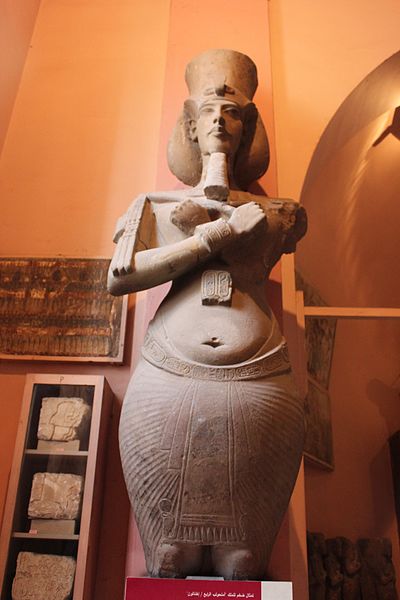Thutmose, also known as "The King's Favourite and Master of Works, the Sculptor Thutmose", was an Ancient Egyptian sculptor in the Amarna style. He flourished around 1350 BC, and is thought to have been the official court sculptor of the Egyptian pharaoh Akhenaten in the latter part of his reign. A German archaeological expedition digging in Akhenaten's deserted city of Akhetaten, known today as Amarna, found a ruined house and studio complex in early December 1912; the building was identified as that of Thutmose based on an ivory horse blinker found in a rubbish pit in the courtyard inscribed with his name and job title. Since it gave his occupation as "sculptor" and the building was clearly a sculpture workshop, the determination seemed logical and has proven to be accurate.
Bust of Nefertiti by Thutmose on display at the Neues Museum in Berlin
A plaster portrait of Tutankhamun, Akhenaten's successor, from the workshop of the sculptor Thutmose, on display at the Altes Museum
Amarna art, or the Amarna style, is a style adopted in the Amarna Period during and just after the reign of Akhenaten in the late Eighteenth Dynasty, during the New Kingdom. Whereas ancient Egyptian art was famously slow to change, the Amarna style was a significant and sudden break from its predecessors both in the style of depictions, especially of people, and the subject matter. The artistic shift appears to be related to the king's religious reforms centering on the monotheistic or monolatric worship of the Aten, the disc of the Sun, as giver of life.
Akhenaten, Nefertiti and three daughters beneath the Aten, Berlin
Two of Akhenaten's daughters, Nofernoferuaton and Nofernoferure, c. 1375–1358 BC. This comfortable and intimate family setting is repeated in other pieces of Amarna art
Princess of the Akhenaten family, Louvre
Akhenaten, Pharaoh of Egypt. Egyptian Museum, Cairo.






